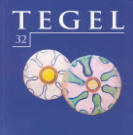 bevat artikelen over de volgende onderwerpen:
bevat artikelen over de volgende onderwerpen:
Tile Production in Antwerp, 1570-1630. A debate paper.
Editorial - page 4
The 2003 annual meeting of the Friends of the Dutch Tile Museum Foundation at Otterlo was largely dedicated to the Antwerp maiolica tile. A survey of tile finds from excavations in Antwerp presented by the city archaeologist Johan Veeckman, brief contributions by a panel of experts and two showcases with archaeological finds in the museum provided a wealth of information about Antwerp tile production.
The discussion focused on the question of Antwerp’s importance after 1570 as a centre for mass produced ornamental, diamond border and circle band tiles. So it was not concerned with the luxury maiolica tile before 1570: the floor and wall tiles or tile pictures made for princes, peers and prelates. Arend Jan Gierveld made the provocative claim that, compared with the northern provinces of the Low Countries, Antwerp was not a major centre for the mass production of tiles. Frans Caignie, on the other hand, argued that there are strong indications of continued tile production in Antwerp till approximately 1630. Both authors have been given a platform here to elaborate their opposing views, as a basis for further research.
Made in Antwerp? Made in Antwerp!
Frans Caignie - page 4
After 1570 a large number of maiolica manufacturers were still active in Antwerp (35 names are known). Even if tiles formed only a minimal part of the total maiolica production, the number of tiles produced must have been considerable.
In the course of the past 50 years a large quantity of maiolica tiles and fragments have been excavated in Antwerp, including, specifically, ornamental, diamond border and circle band tiles from the period under discussion, all of which we state to be made in Antwerp. Several workshops where these tiles could have been made are known through kiln finds or archives.
The Fall of Antwerp in 1585 and the closure of the Scheldt put a serious brake on tile exports from Antwerp. Craftsmen emigrated in large numbers, nine maiolica potters fled the city in this period. So Antwerp exported know-how, not tiles. Tile producers had to sell their products locally. What has happened to all these tiles? Large-scale finds have not been made, but even the find of just a few fragments on a site may be the remains of a not insignificant set of tiles.
In the period after 1570 Antwerp saw the logical continuation of a kind of series production that had already started round 1520.
Certain tile patterns showing the ornamental influence of the Near East, Italy and Spain may have originated in Antwerp. Antwerp was, after all, the birthplace of the earliest tile designs in this region: particularly the palmette motif (as central ornament as well as in the innumerable variations on corner motifs painted in reserve) and geometrical compositions made under Moorish influence.
Antwerp, birthplace of the Dutch tile?
Arend Jan Gierveld - page 14
The ornamental tiles with Moorish geometrical patterns in Dutch collections have an ‘Antwerp’ design, but were mostly made in the northern provinces of the Low Countries (i.e. the present-day Netherlands).
Nearly all the diamond border and circle band tiles in Dutch collections were made in the northern provinces of the Low Countries, and only a small part of the diamond border tiles in Antwerp.
Antwerp exported not so much maiolica products as maiolica potters. Competition with these fellow townsmen who had emigrated was too strong. Military events and politico-economic measures were the cause of the depopulation and decline of Antwerp.
The influence of the Antwerp potters did not extend to the major tile centre in the north, Rotterdam.
If there is a doubt about the provenance of a wall tile - south or north? - the solution is ‘Low Countries’.
Floor tiles in the Netherlands
J. van Loo - page 22
This article traces the development of the sixteenth-century lead-glaze floor tile inlaid with slip as well as the painted tin-glaze floor tile. Partly out of respect for what the authors discovered, this development is shown mostly on the basis of older publications, which are often difficult to access.
The lead-glaze floor tile reached us from France as early as the Middle Ages (De Geus 1940, Renaud 1958, De Jonge 1971, Kok 1949). After 1500 the tin-glaze floor tile came north with Italian maiolica potters who had emigrated to Antwerp. It is to them that we owe the tiles at Herkenrode (Belgium) (Dumortier 2002), Breda (Groneman 1959), Anjum (The Netherlands) (Dingeman Korf 1976/1977) and ‘The Vyne’ in Hampshire (England) (Rackham 1926 and Blanchett 2000), among other sites.
The article mentions a circle border tile with a monochrome brown unicorn, which shows many similarities with the maiolica tiles from about 1600 found at Southwark (south of the Thames in central London). These tiles may have been manufactured by Antwerp maiolica potters who had emigrated to England, where the tiles were possibly applied as floor tiles (Britton 170-175).
Unique for the Netherlands is the floor that was ordered in Delft to be laid at ‘Beauregard’ in France, with large blue tiles depicting soldiers (De Jonge 1971).
In the sixteenth century it would happen that a lead-glaze and a tin-glaze floor tile had identical patterns. After 1580 the floor tile loses ground to the stone floor (marble, for instance), which is increasingly applied in leading citizens' and merchants' residences, certainly in the seventeenth century. The maiolica tile, in particular, is then only sporadically used on floors in the Netherlands. This type of tile is applied on walls. The lead-glaze tile continues to be used as floor tile and ends as indoor flag-stone (Van Dam 1988).
Tile pictures on the rear wall of fireplaces, 1st half 17th c. - part III
J. Herbert van de Berge - page 28
This is the third and last article in a series about Dutch tile pictures on the rear wall of fireplaces dating from the first half of the seventeenth century. The first part, in Tegel 28, was concerned with subject matter and situation; the second part, in Tegel 29, dealt with dating, marks on the back of the tiles and bands of text.
This concluding part firstly discusses tile pictures that deviate from the norm. For instance, most pictures are blue, but a few polychrome ones are known. Also, most pictures are thirteen tiles in height, but other dimensions occur. The subject of very incomplete pictures can sometimes be determined on the basis of iconographic details.
Six different production centres can be distinguished, based on stylistic features and numbering on the back. Where the back is not visible, some tile pictures can be traced to production centres on the ground of their subject matter. However, most of these pictures are still to be attributed to a particular pottery.
Three interesting tiles in the Muller bequest
Minne Iedes Nieuwhof - page 45
This article describes three rare tiles from the Muller bequest. One of them depicts a star-shaped figure, reminiscent of the star that children used to carry from house to house on the feast of Epiphany. The second tile shows a Jacob’s-staff, an astronomical and nautical instrument. The third is a nineteenth-century Iranian tile 190x190 mm, which is an imitation of a Dutch seventeenth-century tile.
The baker
Lida Brouwer-Brand - page 48
Illustration 1 arouses our curiosity: what is depicted here? Illustration 2, which shows a baker and his oven, makes it clear. Illustration 1 represents an oven. The article describes a print and a painting that depict a baker’s life. Another tile shows a so-called ‘ontbijtje’ (Dutch breakfast).
A post-war sgraffito tile picture saved from destruction\
Ton W. A. Hulsebos and Ger J.M. de Ree - page 50
A remarkable tile picture dating from the 1950s was until recently to be seen in the former council chamber of the village of Hoevelaken, in the centre of the Netherlands. The artist Wilhelm Zandvliet was commissioned to provide a suitable design for the tiles. The tile picture was executed in the sgraffito technique. It shows farmers with their horses and chickens, the blacksmith, the sower and sheaves of corn: a rural theme typifying the post-war reconstruction of the Netherlands. The tile picture has been expertly removed from the council chamber wall and is now awaiting a new home somewhere in this charming village.





